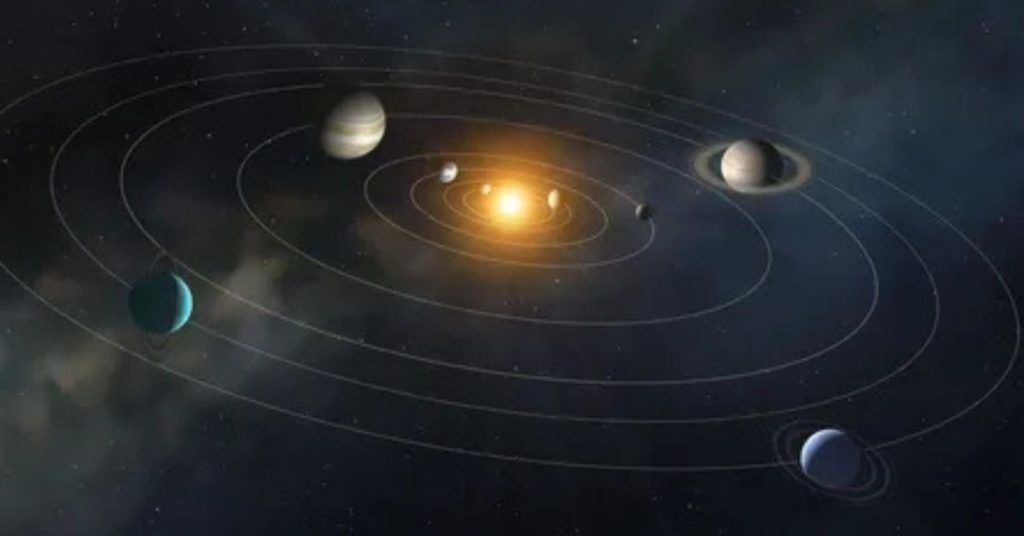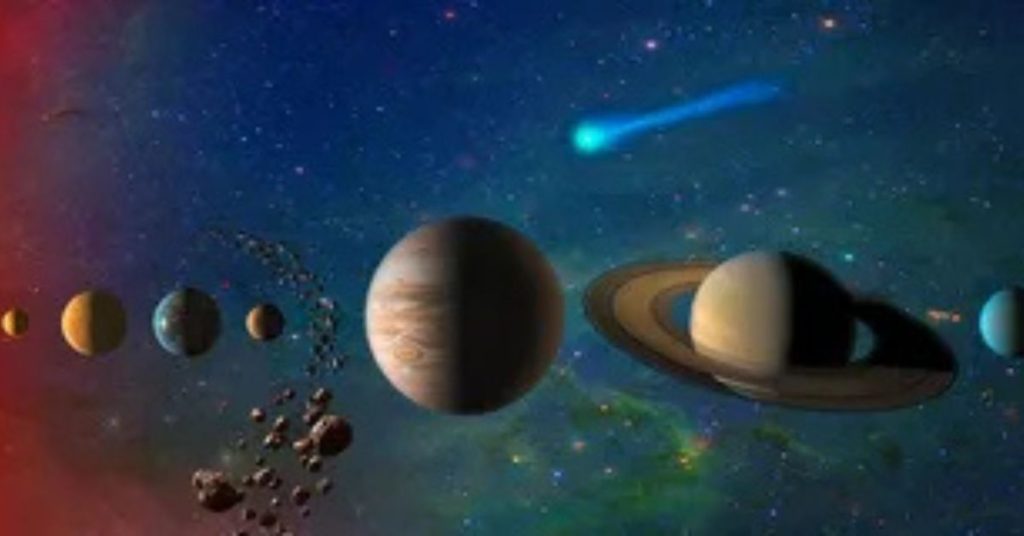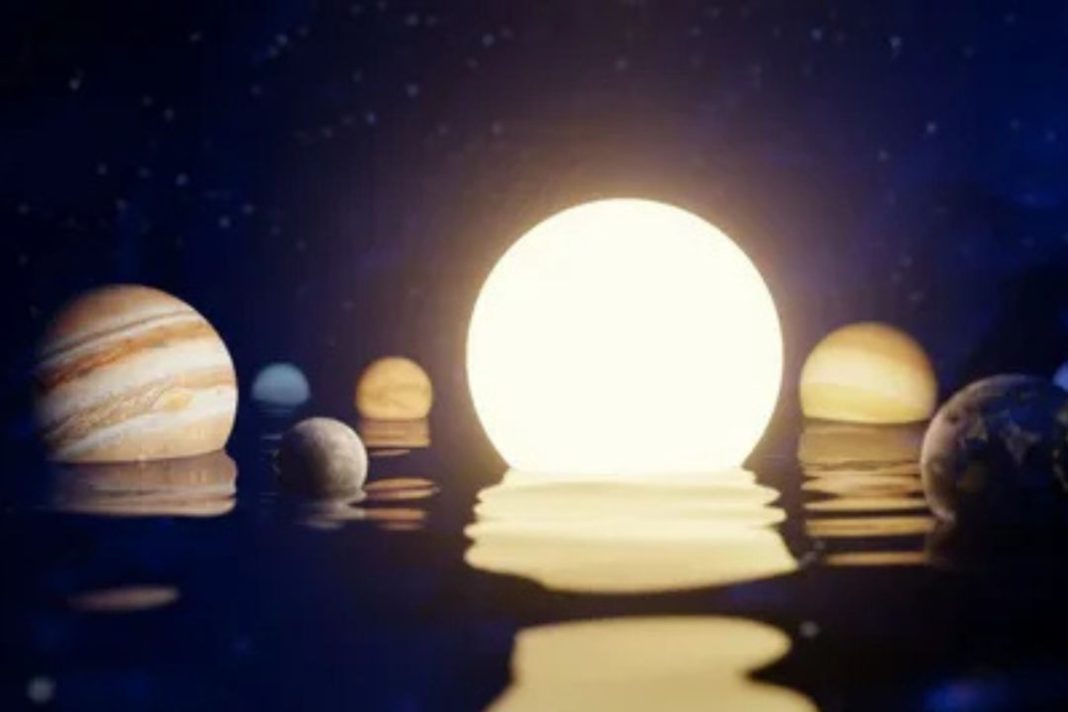Introduction to Sunset on Each Planet
Sunsets are one of the most beautiful natural events we witness on Earth. The sky transforms into brilliant shades of orange, pink, red, and sometimes purple, offering peace, wonder, and reflection. But have you ever wondered what a sunset on each planet in our solar system would look like?
Sunsets are not the same everywhere. The colors, the speed of the sunset, and the appearance of the Sun itself change from one planet to another. This variation depends on the planet’s atmosphere, distance from the Sun, and how fast it rotates. Each planet provides a completely different sunset experience, some calm and colorful, others quick and strange.
Let’s travel across our solar system and observe the sunset on each planet, starting from Mercury and ending at distant Neptune.
What Makes a Sunset on Each Planet Unique?
To understand how a sunset on each planet works, we need to understand a few basic things:
Role of Atmosphere
The atmosphere plays a huge role in the colors we see during sunset. When sunlight enters the atmosphere, it gets scattered by air molecules and dust particles. On Earth, shorter wavelengths like blue scatter more, leaving longer red and orange wavelengths during sunset.
On planets with thick atmospheres, the sky may glow in unusual colors. On planets with thin or no atmosphere, sunsets can be dark and abrupt.
Rotation Speed of the Planet
The rotation speed of a planet plays a major role in how fast or slow a sunset takes place. Every planet spins around its own axis, just like Earth does. This spinning movement is what creates day and night. When the side of a planet facing the Sun rotates away, the Sun appears to move lower in the sky, eventually setting below the horizon. This is what we call a sunset.
However, the speed of rotation is not the same for all planets, and this directly affects how long the sunset lasts. Planets that rotate very quickly, like Jupiter, experience rapid sunsets that may last only a few minutes or even seconds. Jupiter completes a full rotation in just about 10 Earth hours, which means its day is extremely short, and the Sun seems to move across the sky at a much faster pace.
On the other hand, some planets rotate very slowly, which results in long and drawn-out sunsets. For example, Venus has the slowest rotation of all the planets in our solar system. One full day on Venus (one full spin on its axis) takes about 243 Earth days. Because of this extremely slow rotation, the Sun appears to move very slowly in the Venusian sky. A sunset on Venus could last for hours, with the Sun inching its way toward the horizon.
This difference in rotation speed is one of the most important reasons why sunset on each planet is unique. It affects how fast the light fades, how long the sky stays colorful, and how quickly day turns into night.
Distance from the Sun
The farther a planet is from the Sun, the smaller and dimmer the Sun appears in its sky. This affects how bright or dark the sunset looks.
With these facts in mind, let’s study the sunset on each planet in more detail.

Sunset on Mercury: A Flash of Light in the Dark
- Atmosphere: Almost none
- Sky Color: Pure black
- Sun Appearance: Extra-large, extremely bright
- Sunset Speed: Quick and dramatic
Mercury is the planet closest to the Sun, but it has almost no atmosphere. This means sunlight is not scattered at all, and the sky remains black even during the daytime.
During a sunset on Mercury, the Sun appears huge and intensely bright, but as it approaches the horizon, it disappears quickly, almost like turning off a powerful torchlight. There are no colors, no twilight, and no glowing horizon.
Sunset on Venus: A Long and Red Twilight
- Atmosphere: Very thick, full of carbon dioxide and sulfuric acid clouds
- Sky Color: Yellowish in the day, reddish and gray at sunset
- Sun Appearance: Blurred and hidden
- Sunset Speed: Very slow due to slow rotation
Sunset on Venus is completely different from Mercury. Venus has a very thick atmosphere, over 90 times denser than Earth’s. This thick cloud layer blocks and filters sunlight, creating a reddish-gray glow during sunset.
Also, Venus rotates very slowly, taking about 243 Earth days to complete one rotation. This means sunsets are long and drawn out, with the Sun moving extremely slowly across the sky. Sometimes, the Sun might even seem to move backward due to Venus’s retrograde rotation.
Sunset on Earth: The Familiar Radiance
- Atmosphere: Nitrogen, oxygen, and water vapor
- Sky Color: Blue in the day, orange-red at sunset
- Sun Appearance: Bright golden disc
- Sunset Speed: Moderate
We are most familiar with sunset on Earth. The Earth’s atmosphere scatters blue light during the day, and during sunset, the angle of the Sun causes more red and orange light to be visible. This is why the sky turns into warm hues.
Clouds, dust, and humidity can enhance the beauty of sunsets. Depending on weather conditions, sunsets can appear soft and pastel-colored or deeply fiery and dramatic.
Sunset on Mars: The Cool Blue Sunset
- Atmosphere: Thin, mostly carbon dioxide
- Sky Color: Butterscotch during day, blue at sunset
- Sun Appearance: Smaller and fainter than on Earth
- Sunset Speed: Fairly quick
A sunset on Mars looks like something from a dream. The daytime sky is a dusty butterscotch color due to fine particles in the air. But during sunset, the area around the Sun turns blue while the rest of the sky remains tan. This is the opposite of Earth.
This bluish tint happens because Martian dust scatters blue light forward, unlike Earth’s atmosphere, which scatters blue light away. The Sun appears smaller and less bright, and the sunset occurs relatively quickly due to Mars’s rotation speed.
Sunset on Jupiter: Rapid Fading into Gray
- Atmosphere: Mostly hydrogen and helium
- Sky Color: Pale gray or bluish-gray
- Sun Appearance: Small and dim
- Sunset Speed: Extremely fast
On Jupiter, which is a gas giant with no solid surface, the sunset is viewed from its upper atmosphere. The planet rotates very fast — a day on Jupiter lasts only 10 Earth hours. As a result, the sunset on Jupiter is extremely quick.
The sky turns from a bluish-gray to dark within minutes, and the Sun appears small and quickly disappears over the horizon. Due to the lack of a solid surface, one would have to be in a spacecraft or floating balloon to witness a sunset here.
Sunset on Saturn: Golden Glow Dimming to Black
- Atmosphere: Hydrogen, helium, and trace gases
- Sky Color: Pale gold, gray, fading into black
- Sun Appearance: Dim golden dot
- Sunset Speed: Quick
The sunset on Saturn is somewhat similar to Jupiter’s. The sky has a pale golden hue that deepens to gray as the Sun sets. Saturn’s ring shadows can sometimes be seen stretching across its upper atmosphere, creating a surreal and poetic view.
Due to its fast rotation, sunset happens swiftly, and the Sun fades from view within minutes.
Sunset on Uranus: Twilight in Cyan and Green
- Atmosphere: Hydrogen, helium, and methane
- Sky Color: Cyan to greenish-blue
- Sun Appearance: Tiny and dim
- Sunset Speed: Moderate to fast
Sunset on Uranus is unique due to its strange axis tilt. The planet lies almost sideways, which means seasons and sunlight angles are extreme.
Its methane-rich atmosphere gives the sky a greenish-blue color. As the Sun sets, the sky turns deeper cyan, and then fades into a calm, cold darkness. The Sun appears as a tiny speck, but the soft glow of the sky creates a peaceful ambiance.
Sunset on Neptune: Distant Beauty in Deep Blue
- Atmosphere: Hydrogen, helium, and methane
- Sky Color: Deep royal blue
- Sun Appearance: Very tiny and faint
- Sunset Speed: Fast
Being the farthest planet from the Sun, sunset on Neptune is quiet, cold, and dark. The sky is a deep royal blue, which slowly fades into black. The Sun looks like a distant star and disappears quickly, giving way to one of the darkest skies in the solar system.

Comparison Table: Sunset on Each Planet
| Planet | Atmosphere Type | Sky at Sunset | Sun Appearance | Sunset Speed |
|---|---|---|---|---|
| Mercury | Almost none | Black | Large and blazing | Very fast |
| Venus | Thick with sulfur clouds | Reddish-gray | Hidden behind clouds | Very slow |
| Earth | Nitrogen, oxygen | Red-orange | Bright golden disc | Moderate |
| Mars | Thin, dusty CO₂ | Blue around Sun | Small and dim | Fast |
| Jupiter | Hydrogen, helium | Pale gray to dark | Small glowing spot | Extremely fast |
| Saturn | Gaseous with rings | Golden-gray | Dim golden dot | Fast |
| Uranus | Methane-rich | Cyan-greenish | Tiny and faint | Moderate |
| Neptune | Cold, dense gases | Deep blue to black | Distant tiny dot | Fast |
Conclusion: The Magic of Sunset on Each Planet
The sunset on each planet offers a fascinating glimpse into the diversity of our solar system. Though the Sun is the same bright star that lights up every world, the sunset on each planet looks and feels completely different due to variations in atmosphere, rotation speed, and distance from the Sun. From the striking blue sunsets on Mars to the hazy golden light of Saturn and the deepening blue of Neptune’s horizon, the sunset on each planet reveals a unique and dramatic beauty that Earth alone does not capture.
Observing the sunset on each planet allows us to compare how light behaves under different planetary conditions. While some planets, like Mercury, have no atmospheric color at all, others like Uranus and Venus display slow, surreal transitions that last for hours. The sunset on each planet is not only a visual phenomenon—it is a scientific story told through light, chemistry, and motion.
By understanding the sunset on each planet, we stretch our imagination beyond Earth and venture into the realm of planetary science. It reminds us that our home planet is just one of many where the Sun sets, each time in its own magnificent way. The sunset on each planet teaches us to appreciate our skies while igniting curiosity about the alien worlds that share our star. As we learn more about the sunset on each planet, we begin to see the solar system not just as a collection of planets, but as a gallery of cosmic evenings, each one telling a different story. Truly, the sunset on each planet is a window into the soul of its world.
FAQs About Sunset on Each Plane
1.What planet has the most colorful sunset?
Mars has the most unique sunset color — blue — caused by its dust-filled atmosphere.
2.Why is sunset on Earth red, but blue on Mars?
Earth’s thicker atmosphere scatters blue light away and allows red to dominate at sunset. On Mars, the fine dust scatters blue light forward, making the sunset on Mars appear blue.
3.Which planet has the slowest sunset?
Venus has the slowest sunset due to its extremely slow rotation and thick cloud cover.
4.Is it possible to see a sunset on a gas giant like Jupiter?
Yes, but only from high in the atmosphere. Sunset on Jupiter is fast and would be visible from a floating observatory or spacecraft.
5.What planet has the smallest-looking Sun?
Neptune is farthest from the Sun, so during sunset on Neptune, the Sun appears as a tiny, dim dot.




